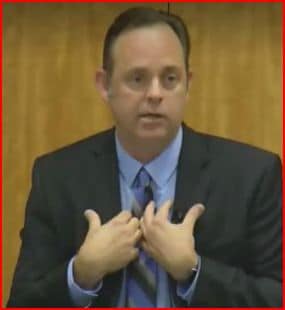
Chris Leonard is President of The Hawaii Association of Broadcasters. He also owns radio stations in Hawaii and was part of an NAB panel Thursday about the role broadcasters play in times of emergency. Leonard was just waking up when the alert that Hawaii was about to be hit by an incoming ballistic missile came in on his phone. Minutes later Leonard was in his car headed to his station when he heard his station air the chilling alert that “this is not a drill.”
Leonard knew, despite the danger, his job was to inform the public about what was happening. He knew he needed to assemble his team and get to work. He thought he was about to spend his final day on earth.
We spoke to Leonard about his experience, what he did when he arrived at the station, and what he thinks can be done to prevent this sort of mistake from happening again.
Radio INK: How did you learn about the alert? Was it through the radio?
Chris Leonard: I was at home. I got the wireless alert which hit my phone and was out of my house inside of 60 seconds. I listened to the full EAS message on my station as I headed to my studios, which is about three miles away from where I live.
Radio INK: Take us through exactly what you did when you first heard? Did you think it was a false alarm?
Chris Leonard: No not at all. When I heard the EAS announcement on my stations, I know how that process works. I was out the door and listening to the message and I know this has come through Emergency management. I verified the source as soon as I got to the station. It has been interesting to watch a lot of the reaction after the fact, how everyone has reacted, like Monday morning quarterbacks, “I knew it wasn’t right” etc. When the system was built, the broadcasters assume, and so should the public, that the message is legitimate and has been thoroughly vetted, that’s why it goes straight through on an automated basis in a situation like that.
Radio INK: Take us through what you did.
Chris Leonard: I’m driving down the street that cuts across town and they’re saying if you’re in a vehicle get off the road and seek shelter. I’m literally watching cars pull off the road and parking, which was an ominous sight. I was really thinking “Is this my last day working.” I’m on the big Island so I’m 275 miles south of Oahu, which I would think would be the primary target in one of these situations, but we don’t have any of that information. We just know we have a statewide incoming ballistic missile threat and I’m racing to the station to get on the air. I had an operator in the building when I got there. I had two phone calls on the way to the station which is about a 3½-minute commute. One was from my program director, who was already on his way. The other was from the morning guy who also was mobilizing to head down there. My wife was in her car.
When I got the alert I rolled over and looked at my wife and said “station.” We were both out the door. I was out the door so fast I was at the station for 10 minutes before I realized the shirt I was wearing was on backwards. I was straight out the door with no time to think about anything. I have two adult children. One is in college overseas and the other that lives on the East Coast. I didn’t even have time to call my kids. All I could think about was they are OK because they aren’t here and I have a job to do.
Radio INK: What is your plan at the station?
Chris Leonard: I took a quick look at the EAS alert, which was scrolling on a display board in the studio, just to look at the source. Make sure that message had gone out to all my stations, get my operators in place. We jumped on different sets of phones. We have three studios in my Hilo office. My wife took our office lines and I grabbed a studio phone. My program director walked in right behind me and immediately opened the mic saying this is what we know, heed the warning and take shelter, and we’ll have more information as it becomes available. I got a call from our mayor who was at the the Emergency Management center at about 24 minutes after the hour to say it was a false alarm and we went right to the air with that. We got a recorded message about a minute later via email and we went straight to the air with that. Apparently, the Emergency management had gone to Twitter and Facebook at about 20 after to say that it was a false alarm. We weren’t monitoring their Twitter feed. The final alert they pushed out, was a second EAS alert, at 38 minutes after the first one. They knew, according to their own press conference, within about three minutes that it was a false alarm. It took 38 minutes to fully communicate that to the public. Certainly there were bits and pieces of information that were getting out there. One of the television stations got on somewhere around 20 afterl, so 13 or 14 minutes after, to say that it was a false alarm. The emergency management officials talked about it saying “we tried to reach out to some of the TV stations and couldn’t get a hold of everybody.” But you don’t have to get a hold of us, that’s what the EAS system is for. That’s where some of the breakdown occurred in this situation. There are some other issues as well. Typically an EAS alert is not issued to say something is not happening and it’s the first time there was consideration to issue a message to say that it was false. There is no header code to say something is a false alarm. The two EAS alerts were issued under two different header codes. The second one came under a different code, and according to the press release from emergency management and the Governor’s office, also sought permission from FEMA to send out a retraction. They later said we didn’t need that. I think the disappointing part is we have systems in place. We have things in the state plan to say this is how EAS is used and they should have gone back to that same channel and could have pushed to 100+ radio and TV station signals statewide plus cable and wireless simultaneously. That happened 26 minutes after a Twitter and Facebook post.
Radio INK: Talk about how your employees reacted when this happened.
Chris Leonard: I’m really fortunate that I have a handful of employees that really understand we play a critical role. We are uniquely situated and equipped to play a specific role to serve the community and it is not lost on a number of my employees. A number of my employees, like my program director and morning guy, have been at the helm for hurricane and tropical storms in the past, as well as earthquakes. So they really understand the impact and importance of what we do and how we do it. I know it’s asking them to make a big sacrifice. Our standing orders are if there is a big earthquake you check your surroundings and if you and your family are safe, then we have a job to do and we go to work. Many of them run and do it. I’m thankful I have people that understand we are uniquely situated and equipped to do that. As a result I do feel obligated to do that. I have been asked before why we do it? And I have said because we can. I feel we should and I would hope if the shoe were on the other foot somebody would be there to do it for us.
Radio INK: Do you worry that this government failure will break a trust between you and your listeners, so the next time they hear it on the radio they won’t believe it?
Chris Leonard: I definitely think there is a certain element of that which is concerning and troubling. I have watched the discussion unfold over the last couple of days, where people are saying “I am going to go to Twitter next time” to get the information quicker. It doesn’t take into consideration that under many emergency situations perhaps data services may or may not still be up. Perhaps those services may not be properly vetted and validated and a whole bunch of other considerations that come up. I think the other big issue for broadcast, and I had this conversation with FCC Chairman Pai Thursday, is with the EAS system. We had two minutes of audio that aired, but once it does it doesn’t rebroadcast. In our case we are live within minutes of the event talking about what we just received, but if a station is automated or not prepared to open the mic and have that information, the message only plays once. If you’re a listener and you hear something is going on and you tune in and just miss the audio message, you assume it wasn’t there. If you didn’t hear it, it didn’t exist. One of the discussions I had is since the system is built not to repeat that message, there should be a provision built in that allows, under certain circumstances, these in particular, that message should air continuously or be repeated in a timely manner. Also, provisions that allow for changing situations. Let’s take for example a chemical spill and the initial message is shelter in place but the winds change so it becomes a mandatory evacuation. The original alert had a duration of time that would reject additional headers. How do you address changing situations or in this case inaccurate information with the framework of the system that’s in place to do that? The technology worked the way it was supposed to to get the first alert out there. It was not used the way I think it could’ve been to get the second alert out in a timely manner.
Radio INK: Do you think there needs to be some form of middle verification? You get the EAS from the government and then somebody in the studio needs to verify, or would that take too much time?
Chris Leonard: I think that is too much time. When they first originally released the EAS for a federal alert there was an authentication protocol but that has gone away. In this particular case it was issued at the state level so that would not have been applicable. In order for that to happen the way it needs to, in the case of a missile attack in Hawaii, if it were coming from North Korea, there’s not time for that and seconds count. Emergency managers ability to get to our stations quickly is crucial and making sure that message is correct is also crucial. As broadcasters, we have to confidence that the message we are receiving is thoroughly vetted and authenticated. Emergency managers have to have confidence that our system is going to be there to deliver that message to the vast majority of the population we serve.
Radio INK: Your adrenaline is running and then you find out it was a mistake by someone pressing the wrong button. What do you think?
Chris Leonard: It took me a while to decompress. I jumped in the car and drove to our Emergency Management Center where our mayor, civil director, and police chief were and we had a conversation. Our county was very proactive and got the information to us much faster than the state did, but they are an essential link in that chain from the state to the county to the local primaries. I had several conversations with our mayor that day and then I immediately reached out to Senator Schatz staff and spoke with the chief of staff that afternoon, since he sits on the commerce committee. One of the concerns I had was when the administration responded they basically said it was a state issue but we’re going to have the FCC look into it. I was clear from the beginning that while this happened in Hawaii it really is a national/federal issue and it could have been any number of places. The initial error that occurred was problematic but the communication process is a critical lesson for broadcasters and emergency managers everywhere in the country. I’m thankful that I have had conversations with Chairman Pai and Commissioner Rosenworcel and they both seem to understand that and are looking into the situation to figure out how we can make this better. I know the FCC has investigators in Honolulu. They and the NAB clearly understand this is an issue with national implications, not just a small state in the middle of the Pacific issue.
Radio INK: What advice do you have for other managers across the country when something like this happens and how important radio is in an emergency like this?
Chris Leonard: I think it is absolutely crucial. One of the discussions on the panel today was about preparedness. I don’t know that there is anything that completely prepares you for this scenario. Thirty years as a broadcaster and this was new ground for me, and I thought I had seen it all. Look at your procedures and personnel to make sure you have people in place, because we play a critical role in this process. It’s important for broadcasters to remind our emergency managers and government officials of the value we bring to the table and the role we play in getting that information out. It is crucial. We have systems in place to do that. It also brings to mind that as cell phones shut down it was tough to make a call. After everyone got the alert they were calling loved ones and you couldn’t make a call because circuits were crashing due to the volume of calls. It brings to attention to me FM chips activated in phones would be a really good thing in these situations.
Chris Leonard can be reached at [email protected]






I live in a strategically risky location – right next to the Michigan, U.S.A./Ontario, Canada shipping locks.
No matter that a 20-minute warning would be issued from any electronic source, the result would be the same – personal and city annihilation.
I understand air-bursted thermonuclear weapons will do that.
Panicked Hawaiian residents and tourists were running to where and with what expectations?
Outstanding interview. Thank you, Radio Ink & licensee, Mr. Leonard. We have the technology. Please use it. Clark, Boston.